Imagine that, instead of 2009, it is 1949, and you were living in a village in Hania. Let's choose a low-lying village that's easy to get around in, like Fournes, rather than a village close to the Lefka Ori, high up in the mountains where my mother was born. Winter is about to depart and make way for the spring; the fields all around the few centrally located houses of the village are verdant with new life. It's time to think about what you're going to cook for lunch tomorrow.
It's a weekday afternoon (if it were a Saturday or a Sunday afternoon, work of any sort would be forbidden) and you've just woken up from your midday nap after the lunchtime meal. You know you've got to make a move on, because by the time you get to the place where you gather your food and get back home, it will be nightfall. Your main concern is to find enough food to feed your family of five children, and one or two aging parents, besides yourself and your spouse.
You leave the house and start walking to the fields, possibly wearing your apron with large in-built pockets, and carrying a woven bag. You won't need your milk pail and egg basket this afternoon; you milked the sheep and goats in the morning and collected all the eggs in the chicken coop just after lunch time when you fed them. In any case, the animals always live close to home, so that they can be protected against the elements. You can't use the eggs from the chickens, or the milk from the sheep, because it's Holy Week at the moment; it's still Lent and you're fasting, in which case you won't be eating any meat or dairy products until Easter Day. The eggs will be used for making koulourakia and tsourekia or saved for dyeing red on Holy Thursday, to be cracked as tradition dictates on Easter Sunday, while the milk will be made into malaka and mizithra, which will be used to fill your Easter kalitsounia and meat pie.
As you walk along by the side of the well-worn path next to the fields (you didn't use the donkey today, as it was already tired out from a journey your husband took over the last two days when he used it to go to the town), your eyes first catch sight of the plentiful mustard greens bordering the road. You keep on walking; mustard greens are everywhere, you have them as a salad for lunch every day. If you don't find any choicier pickings today, you can fill your apron pockets with these wild herbs on the way home.
You're not expecting to find anything new, just the same old stuff you find every day. But you have to come out and forage on most days because there are few ways to store your findings, even if you did manage to pick a lot and carry them on the donkey. Today, your finds will be as much as your hands and pockets can carry. They can carry a lot, but it's never enough: you're feeding at least eight people every time you prepare a meal.
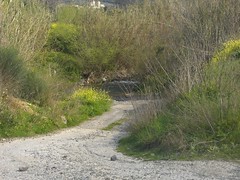
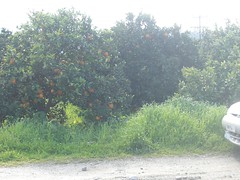
I foraged the greens and the snails from the path leading to the river; this road faced fields of orange and olive trees on the opposite side. As you can see, my 'donkey' was my car.
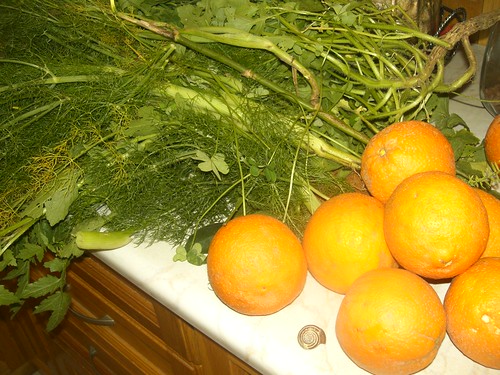
I could have collected many snails on this trip, but we prefer to fatten them up at this time, rather than eat them freshly foraged (we start cooking them in mid-summer). They also taste different after they have been fed flour or macaroni. In the past, you made do with what was available; people probably ate a lot of freshly foraged snails than what we do in our time.
Your first stop is by the river. The fennel has just started to sprout tall. You start snipping off the baby stalks in the brightest green, carefully picking out all the dry bits. As you snip the fennel weed, you notice that the dry stalks of the previous year's fennel plant crop have become homes to the river snails, which have fattened up over the winter period, and are now large enough to eat. Their brown and white rounded shells are easy to spot among the green fennel stalks.
Your pockets slowly start to fill up with snails while your hands are filled with fennel whose aroma is fresh and invigorating, reminding you that very soon, all the snow will melt away from the mountains, and summer with its plentiful harvest is on its way. As you make your way back up the river and onto the main road, you notice your neighbour's orange grove teeming with sweet navel oranges. Your fields are about a half hour's walk, but you're getting tired, and you still haven't gathered any mustard greens, a staple of most of your meals these days. You 'borrow' a few oranges from your neighbour's field, hiding them in your blouse which is tied securely at your waist by the apron strings. (In any case, you know full well that he borrows Valencia oranges from your fields in the summer.) Then you pick a large amount of mustard greens to hide your pregnant-looking belly and make your way back home. There should be enough foraged material to make a decent meal for tomorrow's lunch, to be supplemented by the bread you baked last Monday, table olives, oil for dipping, and maybe a lentil stew.
When you finally come home, you find the children in the midst of raiding the bread bin (most likely a shelf in the kitchen cupboard), so you throw everything you're carrying onto the floor and rush to pick up the 'xiliki' (the large thin rod used as a rolling pin for phyllo - filo - pastry) to shoo them away from the pantry; if they eat up all the bread, you'll have to start making and baking more all over again, and you don't want to start up the wood-fired oven too quickly, as there are other jobs to do.
"But we're hungry, Mama!" cries Number 3, the middle child from your five, perhaps the feistiest of the lot. You have to think quickly. Yesterday you made marathopites (fennel pies); you can't be bothered making those all over again. For tonight's evening meal, you'll try something slightly different (yet very similar) but much easier to prepare: marathokeftedes (fennel fritters).
*** *** ***
Fennel fritters are a delicacy passed onto Crete and the mainland from the Cyclades. They resemble the Greek bifteki (meat pattie) in appearance, but they contain no meat or eggs; hence they are often referred to as a kind of 'poor man's fritter', since they are composed mainly of flour and water. The basic recipe calls for fennel herb and onion added to a seasoned flour-and-water batter, but you can also add some other finely chopped herbs, spinach and/or spices, like cumin and garlic; without these little extra aromas, these fritters can taste very bland.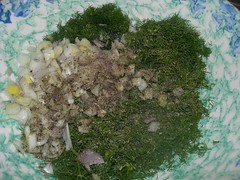
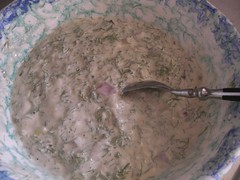
Fennel fritters are not the most exciting meal you will have. In fact, you might wonder how anyone could eat something so bland, unless they had very little to eat. This was probably the case during the last week of Great Lent before Easter, what is known as the Holy Week (the 'Big Week') in Greek: eggs, dairy, meat and fish were off the menu, while permissible seafood was only available to those who lived near the sea and had the money to buy shellfish. So it was indeed the case that there was little variety available at the time.
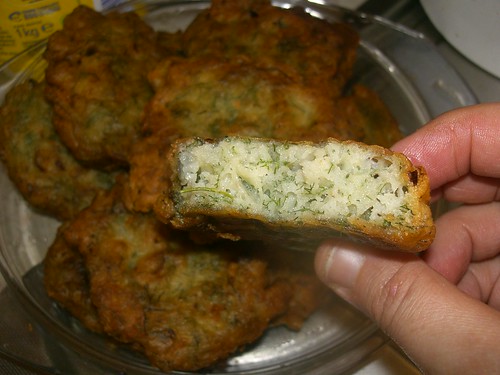
In Western Crete, the equivalent of marathokeftedes (fennel fritters) is marathopites (fennel pasties). All over Greece, every region - even the smaller islands, like Serifos, Mykonos and Tinos - has its own special 'poor man's' fritter and pasty recipe, which could be lenten (vegan) or dairy-based (vegetarian). The dairy-free version is perfect for the Holy Week when frugal meals are cooked using no meat, eggs or milk-based products. Fennel fritters are can also be made with the fennel root, as found in Trukish cuisine.
©All Rights Reserved/Organically cooked. No part of this blog may be reproduced and/or copied by any means without prior consent from Maria Verivaki.
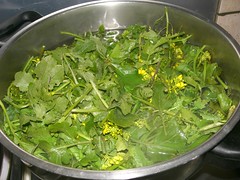
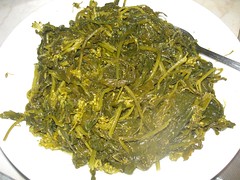
Morning Maria,
ReplyDeleteI've got so many questions.. but can't keep them all in my head.. I really want to learn about horta, I recognise the mustard greens!
I've just followed a link back to making marathopites and mizithropites, in March of last year? When you've made the pastry mixture and formed the balls and then flattened them... can you freeze them then? or do you have to cook them first? Are they all cooked in a pan on top of the stove (even the marathopites)?
How long do you cook the greens and fennel first?
I think that's it for now....................
Kalo Paska
You can definitely freeze everything - i do it all the time. don't cook the patties frozen - cook them when they have slightly (only slightly) thawed, always on a slightly oiled pan.
ReplyDeletei never blanch or cook green for pies, although other cooks swear that they do this before putting them in pies. if you do blanch them, make sure they are strained well of liquids when making the pies, because the pastry will break open and the filling will run out when you try to make and cook them with too much liquid in the filling
Hello Maria
ReplyDeleteThis looks delicious to me. I love greens and would happily eat these fritters any time of the year.
the "Western" Easter has been wonderful here in NZ. Fine weather nearly everywhere (yes, even Wellington, as still is here).
As you move through the days of Holy Week to the celebration on Sunday, I hope your week goes well too. To me it is cooking to enjoy, and then the joy of sharing the celebratory feast on Sunday.
yes - I love cooking.
Thanks again for making contact
michelle in Wellington
Must be fun picking fresh greens from open fields.The crunchy fritters make filling snack,my kids would love it too:)
ReplyDeleteNever knew about fattening up snails. How do you normally store them while they are getting fat?
ReplyDeleteI think I'll pick some snails here at the tail end of summer, when they are bigger.
ReplyDeleteAs for the fennel fritters...that shot of the inside has sold me on it...I love the flavour...worth a try!
The fritters look so delicious!
ReplyDeleteI've never seen (or eaten) mustard greens before - what do they taste like? I wish I was there to pick them with you, I love anything called "green" or "herb", you know!
I love fennel and I think these look fantastic...def a great way to use it up!
ReplyDeleteThe fritters look delicious! I wouldn't know what to do with snails though.
ReplyDeleteΚάποτε θα πρέπει να τους δοκιμάσουμε στην Κρήτη μας!
ReplyDeleteI have the same question as Jeff - how do you keep the snails for fattening.
ReplyDeleteYour narrative is wonderful! From the sound of it, the only difference between your 2009 foray and 1949 is your 'motorized donkey'! As I've never tasted them before, I think the fennel fritters look and sound delicious!
I loved this posting, Maria. Writing it from the point of view of a woman 60 years ago had me thinking of the hardships involved in their lifestyle, especially after the additional strain of WWII. Really interesting. Thanks.
ReplyDeleteI love this post, too, Maria. Fennel is a favorite of mine, and I so enjoy your narrative story. Today, in NYC at the time and place I'm reading this, it's Great Holy Friday. In case I don't get back to your blog before Sunday, I wish to say: Kalo Paska!
ReplyDeleteBTW, Maria... your link to the marathokeftedes (fennel fritters) is not working. I'd like to get a recipe for that.
ReplyDeleteHere's the lowdown on snail fattening:
ReplyDeletehttp://organicallycooked.blogspot.com/2008/06/snail-harvesting.html
Another fascinating post Maria, interesting comparison between then and now, the only change seems to be the "steed." :-)
ReplyDeleteI also loved all the info on snail harvesting and fattening. Oh, and the fennel fritters look scrummy.
i've changed the links to make them all work (hopefully)
ReplyDeleteLovely story. Delicious food.
ReplyDelete